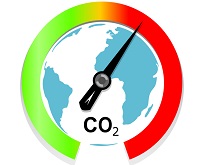Eurostat has just released a new section on its website dedicated to ‘Climate change’. It brings together statistics from various domains, such as environmental, social and economic statistics, in an easily accessible and structured way, to help you find data to better understand, analyse and monitor climate change.
Climate change concerns all of us. We need statistics on this subject to help us analyse the drivers, impacts and adaptation to climate change. Also, these statistics provide a wealth of interesting information – just read for yourself:
Do you know for example how much your and all the other households in the EU contribute to CO2 emissions, which are one of the main drivers of climate change?
In 2016, households in the EU generated around a quarter of the total direct carbon dioxide (CO2) emissions produced in the EU, amounting to 1.7 tonnes per person. The lowest value was registered in Bulgaria (0.3 t/person) and the highest in Luxembourg (2.9 t/person).
And how do you “produce” these CO2 emissions?
More than half (55%) of the CO2 emissions of EU households in 2016 came from transport activities, such as taking the car to work or a plane to go on holiday. A further 44% came from households heating their home. The remaining 1% was generated by other activities, such as emissions from spray cans and electric lawn mowers.
Now you learned more about how you directly – meaning through your own activities – contribute to CO2 emissions…
…but did you know that you also contribute indirectly to CO2 emissions? How do you do that?
Everything you buy - be it a litre of milk, a new pair of shoes, a sofa - needs to be produced and during this process CO2 emissions are generated.
How high are these indirect emissions and what causes them?
Indirect CO2 emissions by EU households amounted to a further 3.6 tonnes per person in 2016. Almost one quarter (22% or 0.8 t/person) of these indirect emissions came from the use of electricity. Other major sources were 'food, beverages and tobacco products' (11% or 0.4 t/person) and 'accommodation and food services' (6% or 0.2 t/person). The remaining 61% or 2.2 t/person are made up of many other goods and services.
Curious to find out more?
Then take a look at our new dedicated section…
If you have any comments or questions, please contact us via estat-user-support@ec.europa.eu.

